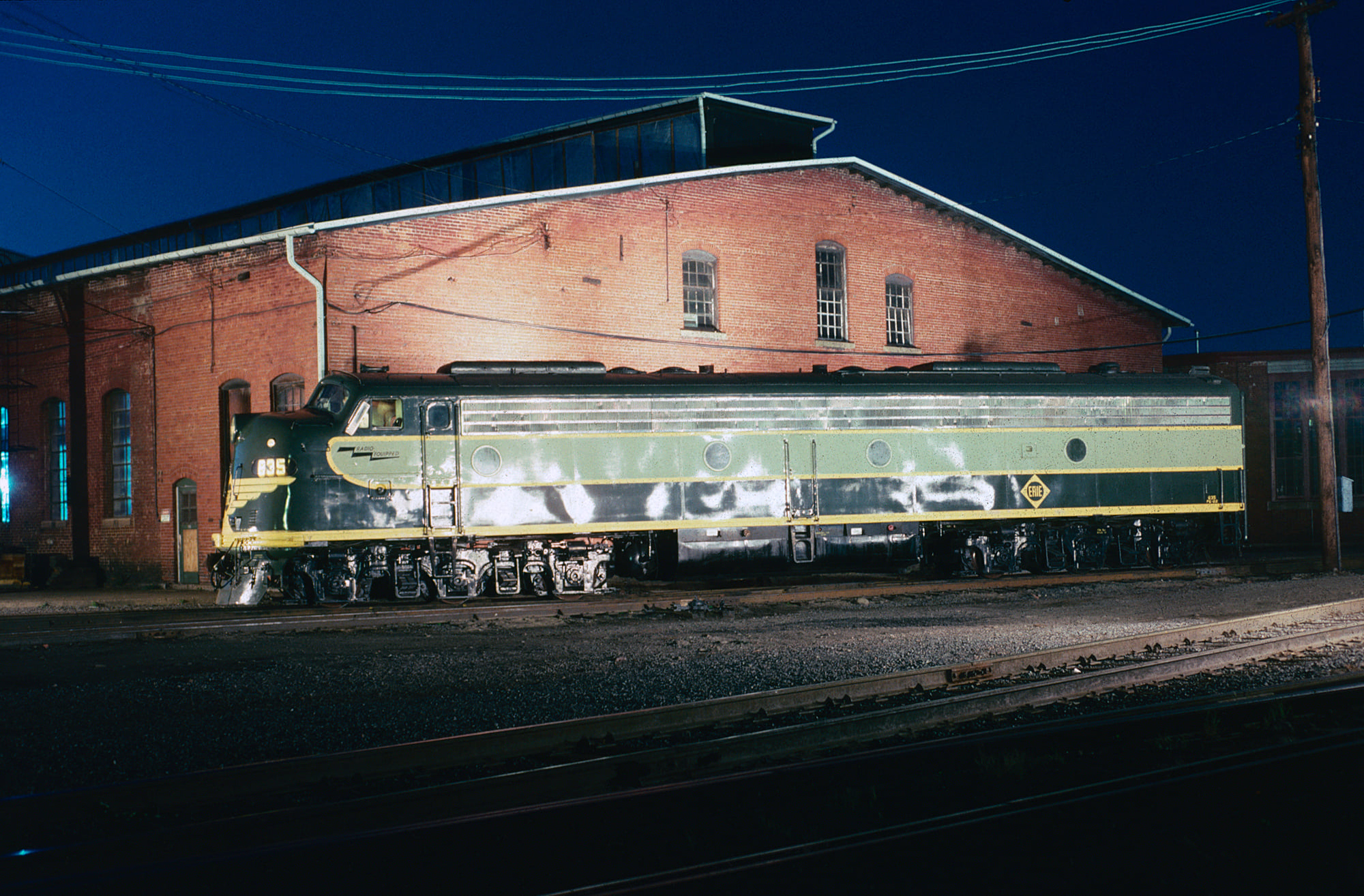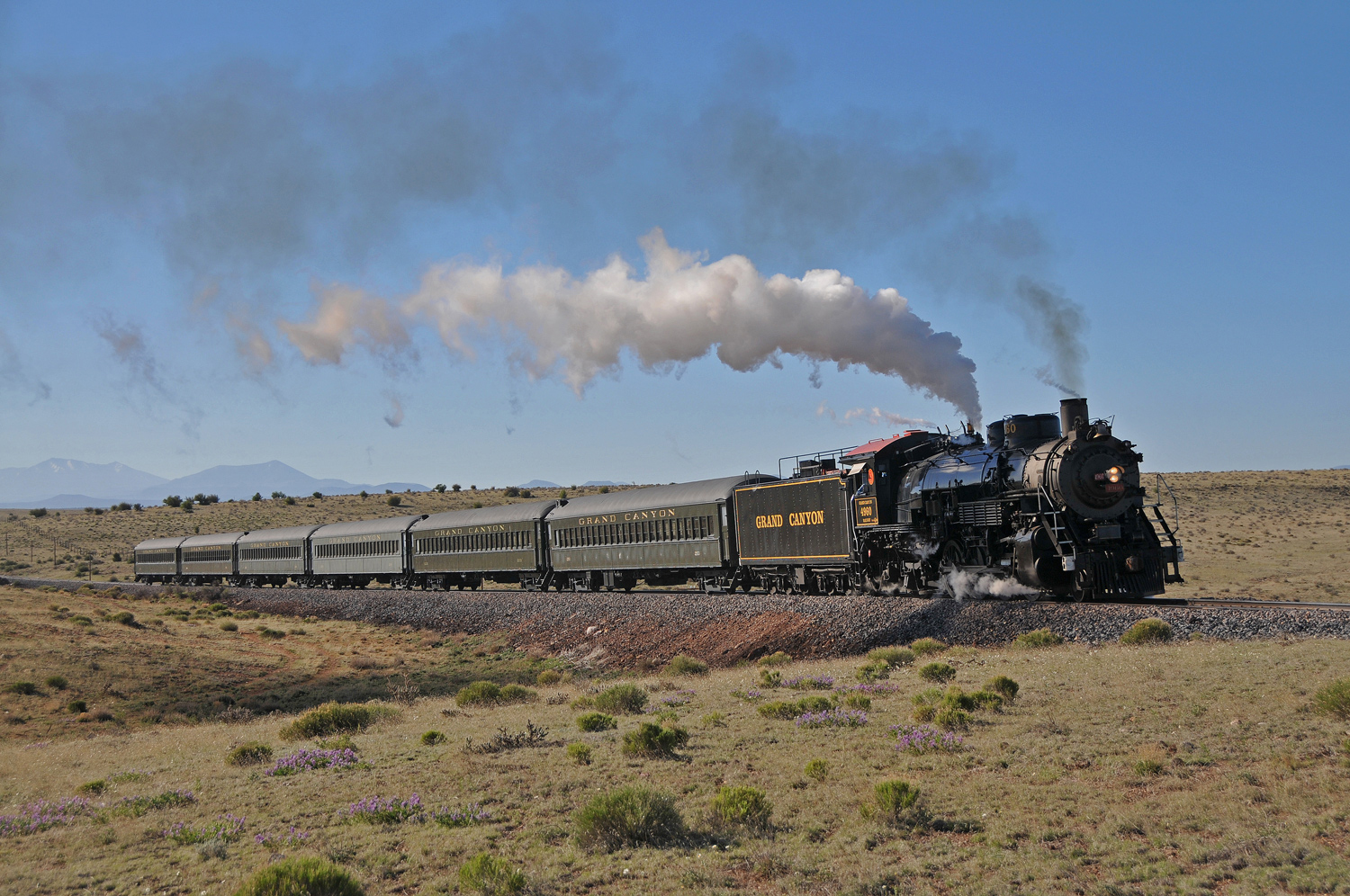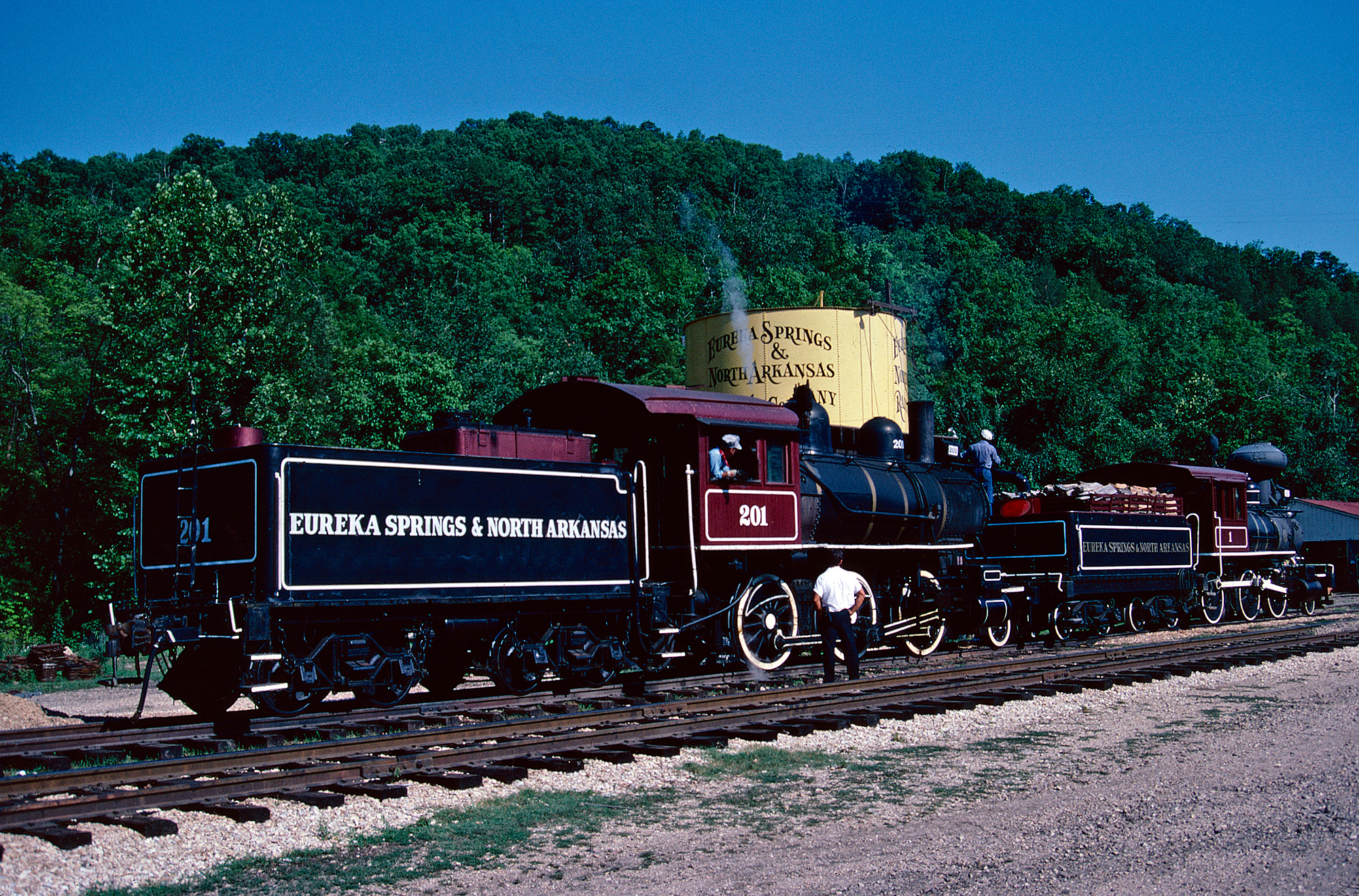Erie E8A #835: Specs, Photos, Overview
Published: July 8, 2024
By: Adam Burns
Erie E8A 835 is more than just a locomotive; it is a symbol of the golden age of American railroading. Technically, there was never such a locomotive although this particular unit proudly wears the company's classic passenger livery.
With a rich operational history, subsequent preservation and restoration efforts, and distinguished specifications, 835 stands as an exemplary model of mid-20th century diesel-electric technology.
This article briefly explores the life and legacy of the locomotive, offering a comprehensive overview of its journey from active service to preservation.
 Erie E8A #835 during a night photo shoot at Steamtown on September 18, 1992. F. Oltmann photo. American-Rails.com collection.
Erie E8A #835 during a night photo shoot at Steamtown on September 18, 1992. F. Oltmann photo. American-Rails.com collection.Operational History
The Erie Railroad, an iconic American railway, was renowned for its expansive network and innovative approach to rail transport.
During the early 1950s the Erie sought to modernize its passenger fleet, which led to the acquisition of several E8A locomotives manufactured by the Electro-Motive Division (EMD) of General Motors. Delivered in between January and March, 1951 the company's fleet totaled 14 units, numbered 820-833.
The E8A model, with its streamlined design and reliable performance, was favored by many railroads in the United States. Erie's fleet was primarily assigned to haul passenger trains, including some of the railroad's most prestigious Chicago services such as the Lake Cities, Pacific Express, Erie Limited, and Atlantic Express
Performance and Service
In service, Erie 835 was actually a Pennsylvania Railroad unit. Built as #5788 in May, 1952 it was long used in main line passenger service for decades, and later numbered 4248. It retained this number into the Penn Central era
The New Jersey Department of Transportation acquired the locomotive from Conrail in December 1976, also designating it as 4248 for use in New Jersey Transit's commuter service.
The locomotive was subsequently rebuilt at Conrail's Elizabethport Shops in October, 1979. After aquisition by the United Railway Historical Society it was adorned in the Erie's passenger livery in April, 1991 to operate along with former New York Central E8A #4076 which had also been adorned in Erie's scheme as "#834" a few months prior (November, 1990).
#835 played a prominent role on New Jersey Transit's New Jersey Coast Line, engaging enthusiasts on fan trips between Hoboken and Bay Head, NJ.
Today, neither locomotive is operational and sit in states of disrepair at Lebanon, New Jersey. However, future plans are to eventually repaint 835 as Erie Lackawanna Railway 835 to showcase at the the New Jersey Transportation Museum in Phillipsburg, NJ.
Specifications
The E8A locomotive boasts a set of specifications that underline its engineering prowess and suitability for passenger rail service:
- **Manufacturer**: Electro-Motive Division (EMD) of General Motors
- **Model**: E8A
- **Build Date**: 5/1952
- **Owner/Number**: Pennsylvania 5788
- **Serial Number**: 15653
- **Order Number**: 6354
- **Engine Configuration**: Twin 12-cylinder 567B engines
- **Horsepower**: 2,250 hp
- **Length**: 70 feet 3 inches
- **Weight**: Approximately 315,000 pounds
- **Top Speed**: Approximately 85-90 mph
- **Tractive Effort**: 31,000 pounds
- **Fuel Capacity**: 1,200 gallons
These specifications ensured that the E8A locomotives were capable of handling the demands of high-speed passenger service with efficiency and reliability.
Preservation and Restoration
Initial Preservation Efforts
Following its retirement, E8A 835 faced an uncertain future. Many locomotives of its era were scrapped as railroads transitioned away from first-generation diesel-electrics. However, recognizing its historical significance, rail enthusiasts and preservation groups took action to save this iconic locomotive.
In the 1980s, 835 was acquired by the United Railroad Historical Society of New Jersey (URHS), a non-profit organization dedicated to preserving New Jersey's railroading heritage. The locomotive was transported to Boonton, New Jersey, where it became part of the URHS's growing collection of historic railway equipment.
Restoration Process
Restoring 835 to its former glory was a labor-intensive process requiring meticulous attention to detail. The restoration team embarked on a mission to return the locomotive to its original Erie Railroad livery, a striking maroon, yellow, and gray paint scheme that evoked the elegance of the mid-century passenger service.
- **Exterior Restoration**: The locomotive's exterior was stripped, sanded, and repainted in the authentic Erie colors. Original decals and insignia were painstakingly recreated to ensure historical accuracy.
- **Interior Rehabilitation**: Inside, the restoration team focused on restoring the cab controls and instrumentation to operational condition. The locomotive's mechanical and electrical systems were overhauled, with worn components repaired or replaced.
- **Engine Overhaul**: The twin 12-cylinder 567B engines, the heart of E8A 835, underwent significant refurbishment. This included cleaning, repairing, and testing to ensure that the locomotive could once again run under its own power.
Public Display and Operation
Following its restoration, Erie 835 became a centerpiece of railway heritage events and excursions. It made appearances at rail festivals, special excursions, and educational events, allowing new generations to experience the grandeur of mid-20th century rail travel.
One such event was the annual "Transportation Heritage Day," where the URHS showcased its collection, offering cab tours and photo opportunities with E8A 835. These events not only honor the locomotive's legacy but also highlight the importance of preserving America's railroading history.
Legacy of E8A 835
Erie 835 serves as a poignant reminder of an era when rail travel was a primary means of intercity transportation. Its operational history reflects the evolution of passenger rail service, from the height of mid-century travel to the challenges faced by railroads in the latter half of the 20th century.
The locomotive's preservation and restoration efforts underscore the dedication and passion of railway enthusiasts who work tirelessly to keep history alive. Throughout the 1990s the handsome engine led many fantrips throughout the Northeast, alongside "Erie 834."
Conclusion
The story of Erie 835 is one of innovation, service, decline, and renaissance. From its early days hauling prestigious passenger trains to its retirement and subsequent resurrection, the locomotive embodies the spirit of American railroading.
Its preservation stands as a testament to the enduring legacy of the Erie Railroad and the broader historical narrative of rail travel in the United States.
Unfortunately, the engine's future remains uncertain although hopefully funding will eventually allow for the locomotive's cosmetic restoration.
Recent Articles
-
Arizona Railroad Museums: A Complete Guide
Apr 16, 25 01:17 PM
Learn about Arizona's rich history with railroads at one of several museums scattered throughout the state. More information about these organizations may be found here. -
Arkansas Railroad Museums: A Complete Guide
Apr 16, 25 12:59 PM
The state of Arkansas is home to a handful of small railroad museums. Learn more about these organizations here. -
Alabama Railroad Museums: A Complete Guide
Apr 16, 25 12:30 PM
Alabama, with its storied past and vibrant connection to the railroad industry, is home to several captivating railroad museums.

